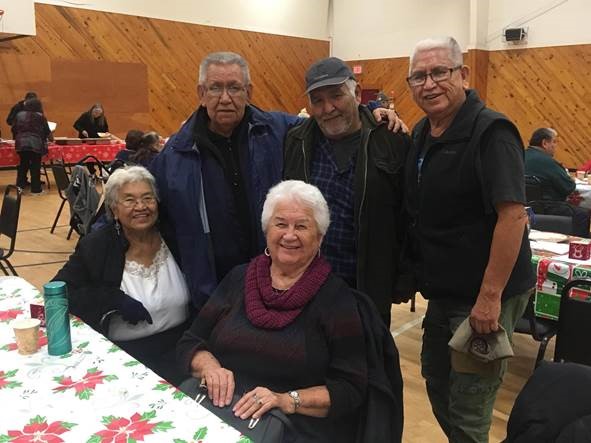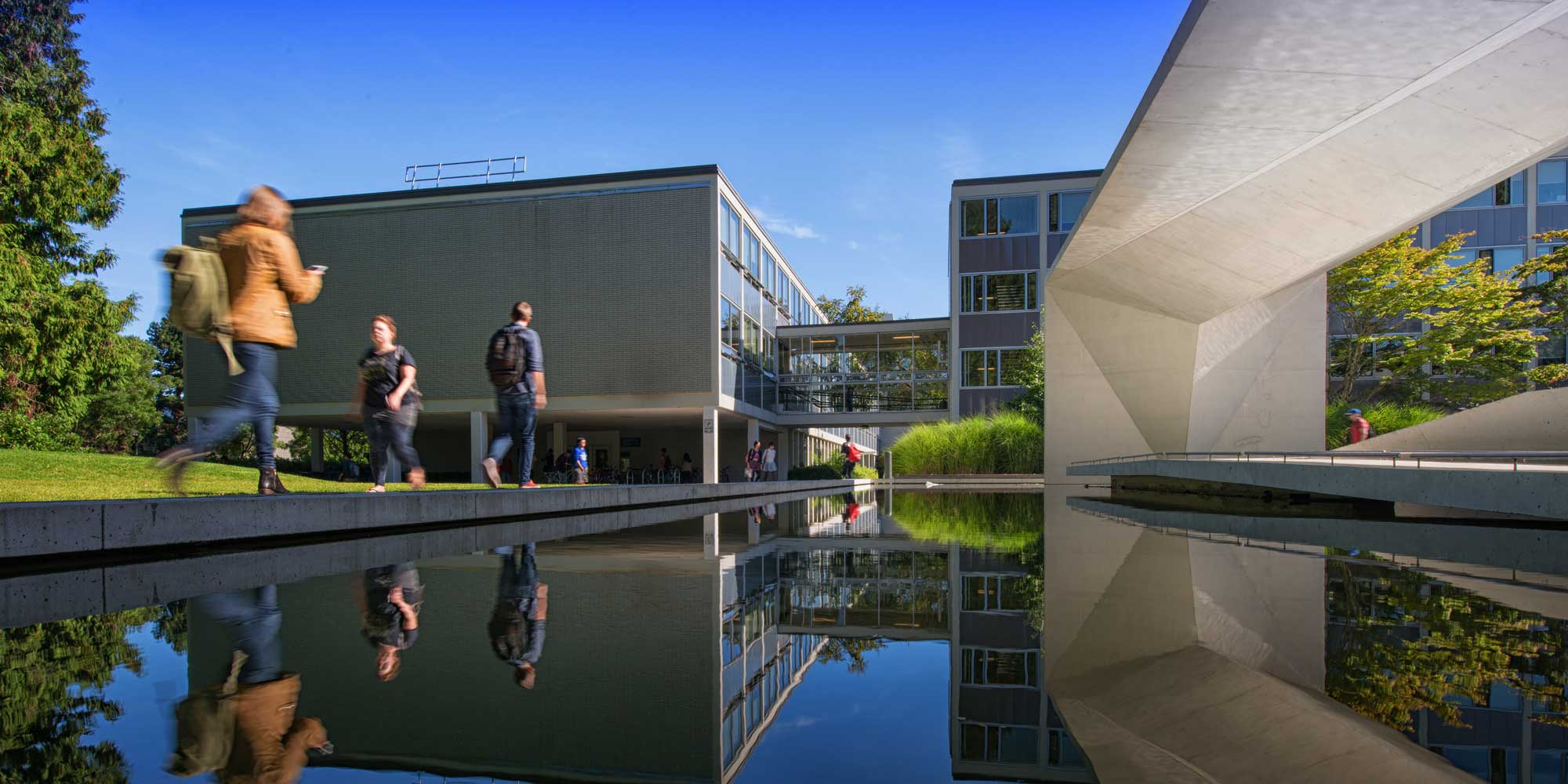

Featuring Elders from the four sister nations. Top left to right: Freddie Louie, Randolph Timothy SR, and Eugene Louie. Bottom left to right: Maggie Wilson and Elsie Paul. Image provided by Koosen Pielle.
Homalco, Klahoose, Comox, and Tla’amin Nations have been working on revitalizing their language, ʔayʔaǰuθəm (ay-a-ju-them), for over two decades. In the last seven years, an e-dictionary of First Peoples’ sounds and stories was brought to life through the efforts of community members, jehjeh Media, and UBC Linguistics alum Dr. Marianne Huijsmans.
To gain a better understanding of this meaningful collaboration, Koosen Pielle of the Tla’amin Nation (ɬaʔamɩn gɩǰɛ) and Marianne discuss their purpose, how the project is focused on documenting culture for the next generation. The interconnection between land, language, and community, will be tied together through the ʔayʔaǰuθəm e-dictionary on the FirstVoices platform. Marianne quotes a team member who said “a lot of them aren’t straight across translations between ʔayʔaǰuθəm and English, so it takes in a whole different worldview when you’re looking at some of this language and some of these words. We all say languages and cultures are connected, but it also looks at not just language and culture, but a different worldview.”
Recently supported by the Community-University Engagement Support (CUES) Fund, the ʔayʔaǰuθəm e-dictionary project team are now able to gather and unite all four communities more frequently. In conversation with the Community Engagement team, Koosen and Marianne shared some insights about the stories that words hold, community that language builds, and the reciprocal partnerships that resulted in meaningful and lasting relationships.
This editorial is part of an ongoing series that dives into CUES-funded projects and highlights the achievements of Community-University partnerships.
Can you tell us about how the project got started, why it’s important to you, and what community goals you’re hoping to address?
Koosen: The project began through one of our language warriors, ʔošil, also known as Betty Wilson. She played a pivotal role in uniting our four sister nations to collaboratively work towards preserving ʔayʔaǰuθəm. Before Betty’s intervention, each nation was independently trying to save the language. We were all working in isolation, struggling to pool our resources and make any significant progress.
ʔošil was the catalyst that brought us together. She ensured we were all aligned in our goals and even managed to get us all in the same room. Through her, we were introduced to various learning opportunities, from understanding the nuances of spelling to delving deeper into our writing system. In hindsight, I realize she was subtly preparing us for the e-dictionary project, all without explicitly mentioning it. Her brilliance is undeniable, and she’s the primary reason we’re all here today, united and motivated.
“Our long-term vision is to see ʔayʔaǰuθəm seamlessly incorporated into everyday life. In the short term, we aim to equip our community with the necessary tools to make this vision a reality.”
Can you share an overview of the project’s key milestones so far?
Marianne: The huge thing that initiated this project was ʔošil, or Betty’s efforts. She envisioned the four communities collaborating on this project. One significant step she took was discovering that Henry Davis, my supervisor at UBC, was seeking a SSHRC grant to develop dictionaries for other Indigenous languages. She then inquired if the four nations could join this endeavor, with ʔayʔaǰuθəm being one of the dictionaries. Henry agreed, and that’s how it all began…This consolidation was a monumental step. We wanted to ensure that all our recordings were primed for upload once a shared dictionary site was operational. This meant revisiting translations, verifying them collectively, and cross-checking spellings. It was at this juncture that we considered seeking support from CUES for the forthcoming phase of our work.
What has been your favourite experience or outcome of the project?
Koosen: payɛštʔot qəsqəsƛačɛm — we’re always laughing — and that’s probably the biggest thing. Yeah, we’re always laughing and everything is so much funnier in the language, truly. Some of the highlights? Just being together. We have all been separated from colonization and from policies that aren’t ours.
I don’t need to delve too deep into that, but language is something that we all share. It’s the thread that’s reuniting us, essentially. Oh, how I adore being a part of this journey! There are these moments where a translation in the language just resonates, where it suddenly clicks. I remember once, I was producing an audio play based on a legend my granny shared back in the ’90s. While editing, I kept hearing her use the word nɛkʷayu. At the time, I didn’t recognize it. Fast forward a few months, and during a dictionary session, there it was, right in front of me on paper. I thought, “Oh my God, she was referring to a meadow!” I was clueless then, but that repeated exposure, the chance to hear it multiple times, made the connection possible.
It’s huge, really, having that opportunity for repetition and to learn directly from our elders.
Marianne: One thing that really struck me was how focused everyone has been on the next generation. Everyone was either mentioning the next generation or their grandchildren or their nieces and nephews. This is for the next generation and so we have everybody committed to that and able to work together towards that. You know, it’s fun to be together with such a great group of people with everyone focused. Everyone’s hearts and minds are really in the same place for this.
“One of my absolute favorite words to introduce is 'ǰɛǰɛ' (pronounced jehjeh). This term can mean your relative or your cousin, but it also signifies 'tree'. To think of trees as our kin, our family, paints a distinct contrast from the perspective many English speakers might have.”
What strengths did each party bring to the project?
Marianne: I truly believe I’m the luckiest linguist. Partnering with the awesome four nations has been a privilege, and the welcome I’ve received has been heartwarming. I am indebted to the personal relationships and friendships we’ve cultivated. It’s this bond that sets the foundation for the work we do together.
When I arrived, everyone was already deeply immersed in the language. A lot of groundwork had been laid, and I was hoping my linguistic background would be of value. But there was so much for me to learn beyond just the language itself. The community had been diligently working on dictionary projects for years—a domain I was unfamiliar with. So, I found myself learning immensely from the passionate, dedicated, and knowledgeable community members.
I recall when we embarked on the CUES project, our goal was to review words swiftly, given the volume we had to cover. But Betty, one of our elders, stressed the importance of attaching an example sentence to every word. We’d originally set this as an objective but hadn’t given it enough focus, especially in our initial rush. This practice turned out to be instrumental. By analyzing these sentences, we gained a deeper understanding of the translations. This was a pivotal moment in my learning journey.
“Every day, I discover something new, be it about the culture or linguistics. The term č̓ɛč̓ɛhaθɛč, for instance, is one of the words which has really impacted my worldview. It translates to 'thank you', but it's also 'welcome you'. The term is used in a variety of contexts and it offers such a distinct level of thanks compared to just saying thank you. It's like an offering of respect. The insights and experiences I've gathered from working with everyone are boundless.”


